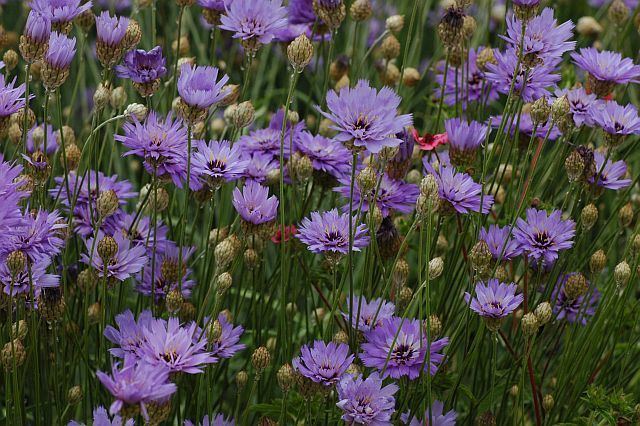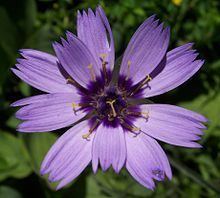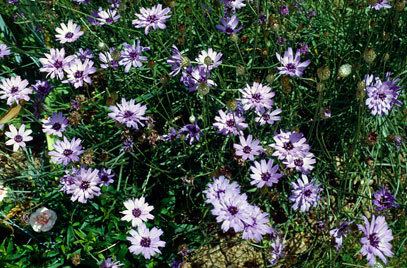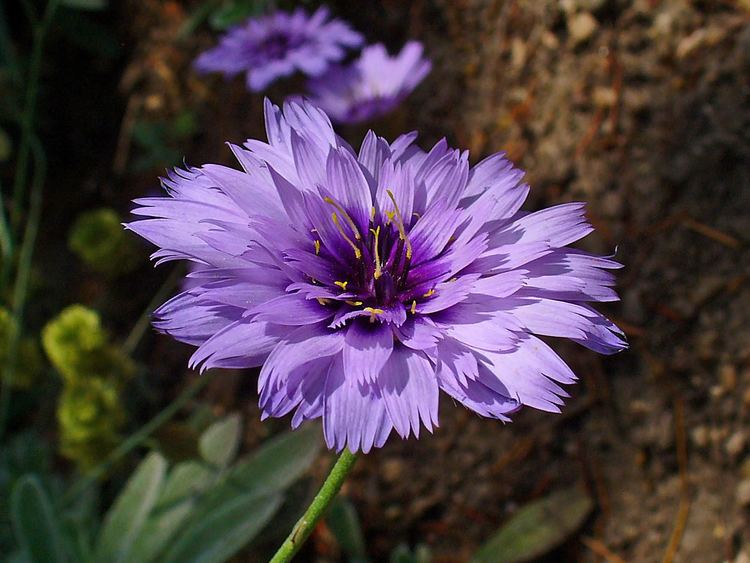Kingdom Plantae Higher classification Catananche | Scientific name Catananche caerulea Rank Species | |
 | ||
Similar Catananche, Centranthus ruber, Centranthus, Sidalcea, Schizostylis | ||
Catananche caerulea is a greyish green perennial herbaceous plant with a basal leaf rosette and conspicuous blue-purple or sometimes white flowerheads, belonging to the daisy family. It is a popular garden plant and is often used in dried flower arrangements. Its vernacular names in French are catananche bleue, cigaline, and cupidone bleue, in German it is called Blaue Rasselblume, while in Italian it carries the name cupidone azzurro. In English it is sometimes called Cupid's dart.
Contents
- Catananche caerulea ou catananche bleue cupidone bleue cigalin
- Description
- Leaves and stems
- Flowerheads florets and fruits
- Etymology
- Distribution
- Ecology
- Cultivation
- References

It is native to the Mediterranean region. The flower was supposedly used by the ancient Greeks as a key ingredient in a love potion, hence the common name "Cupid's dart".

Catananche caerulea ou catananche bleue cupidone bleue cigalin
Description
Cupid's dart is a short-lived perennial herbaceous plant, of 20–90 cm high. It has eighteen chromosomes (2n=18).
Leaves and stems

There is a basal rosette of many linear leaves of 2–20 cm long and ¼–¾ cm wide, which may be entire or are pinnately incised, creating linear lobes mostly directed towards the tip. The leaves are covered in long soft woolly hairs (pilose) lying on the surface, giving both leaf surfaces a greyish green color. The leaf tips may be blunt or pointy, and the leaf blade gradually narrows to the main vein at the base of the leaf. From the heart of the rosette one or a few, strongly branched, erect, again woolly haired and greyish green flowering stems rise. These stems carry only a few leaves, similar to the basal leaves, but up to 30 cm long, with up to four lateral lobes.
Flowerheads, florets and fruits

Flowerheads are set individually at the end of a branch of up to 30 cm long, with a few small papery bracts, more densely set near the flowerhead. Flowerheads are enclosed in an involucre of 1½–2½ cm long, which has a diameter of 1–2 cm. The individual bracts are papery, egg-shaped, 1–2½ cm long, ⅓–½ cm wide, hairless and ending abruptly in a small sharp point as a continuation of the darker colored midrib. The common base at which the florets are implanted (or receptacle) is flat, with a scale subtending every floret. The ligulate florets have a bluish purple strap ending in five teeth, 2½–2⅞ cm long, while the tube is darker. The one-seeded indehiscent fruit (called cypsela) is cylindrical with five to ten longitudal ribs, 5–6 mm long, and is crowned with papery pappus scales. The pollen is yellow.
Etymology

The simple translation of the root words from the Greek κατάνάγκη (katanagkē), itself a contraction of κατά (kata), "down" and άνάγκη (anagkē), "force", is "compulsion", which is suggested to refer to the use of this plant in love potions, and is reflected in the vernacular name Cupid's dart. The species epithet caerulea is the Latin for "(heavenly) blue".
Distribution

Cupid's dart occurs in the wild in western North-Africa (Morocco, Algeria, Tunisia and Libya) and south-western Europe (Portugal, Spain including the Balearic Islands, Andorra, France, and Italy). It is naturalized in Czechoslovakia and may temporarily occur elsewhere when it escapes from cultivation.
Ecology
Catananche caerulea naturally occurs on disturbed, young or eroded, carbonaceous soils, in plant communities consisting of dwarf shrubs and perennials. It is often associated with different Cistaceae such as Fumana laevipes, Helianthemum apenninum, H. cinereum, H. marifolium, H. croceum, several Lamiaceae such as Lavandula latifolia, Rosmarinus palaui, Teucrium capitulatum, and T. haenseleri, several Asteraceae such as Rhaponticum coniferum, Scorzonera hispanica, Serratula flavescens and S. pinnatifida, few Fabaceae like Astragalus glaux and Ononis pusilla, parasites such as Cytinus ruber and Orobanche latisquama, and other species such as Aristolochia pistolochia, Euphorbia nicaeensis, Globularia vulgaris, Ruta chalepensis, and Viola arborescens.
Cultivation
C. caerulea is grown in the garden as an ornamental short-lived perennial, which may re-seed spontaneously. It prefers full sun with good drainage. It is drought tolerant.
The variety C. caerulea 'Major' has gained the Royal Horticultural Society's Award of Garden Merit. Several selections are grown, among which 'Amor Blue', 'Major', supposedly with larger flowers, 'Alba' and 'Amor White', white with purple floret tubes.
